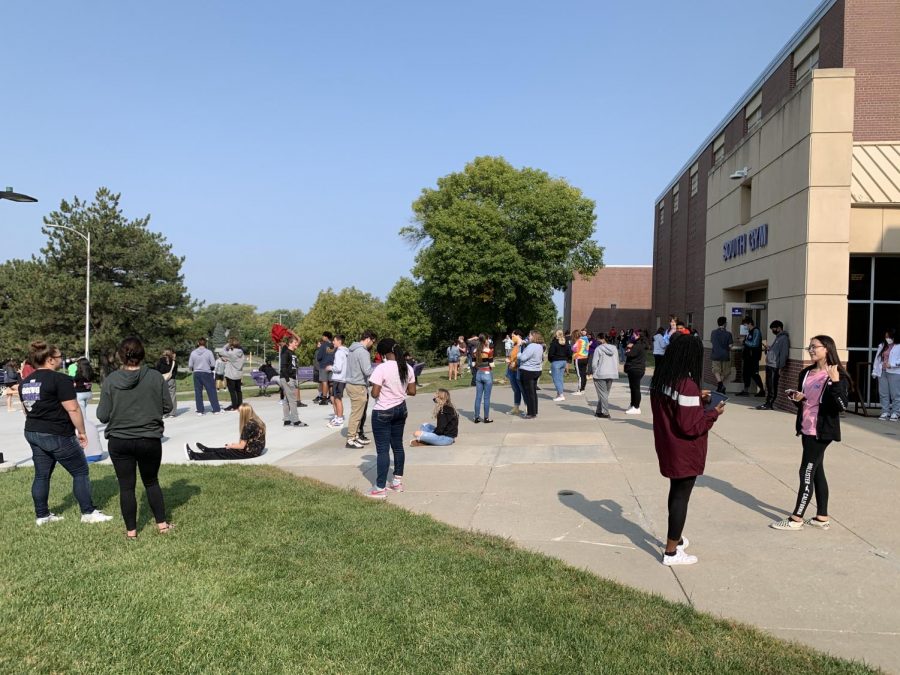Socializing in the world of COVID
October 6, 2020
Socializing has largely changed due to the effects of COVID-19, and the following guidelines set in place to keep people safe.
With the end of last school year being cut short, and many changes being implemented this year, the way people interact with each other looks very different. The World Health Organization has multiple guidelines on its official website, most of which are things that the average student normally would not follow, if it wasn’t for COVID-19. These guidelines consist of things like regular hand washing, maintaining 6 feet of distance between people when possible, and avoiding touching your face and eyes, among others. All guidelines can be found on the WHO’s official website. These changes have added not only physical distance, but also emotional distance for some students as well.
“Your peer interactions are very very important to your development of who you are and who you’re becoming,” Dr. Rausch, Bellevue East’s resident psychologist, said. “There are some families that are super supportive and accepting and developing a student’s identity struggles and awareness that typically come during high school. There are some other families that that’s a real challenge for them,”.
Rausch said that socialization is very important for students, and that being not only quarantined, but distanced could have affected students in varying ways. Rausch said that some students that she had been working with made improvements during the distancing over the spring.
“People have said ‘oh you know we’re all in the same boat,’ no we’re not. We’ve been through the same storm, but we’ve weathered it in different boats, and it’s a lot different to weather a storm in a yacht than it is to do it in a fishing boat,” Rausch said.
Many things have been changed in an effort to prevent the spread of the coronavirus. Hallways have been designated as one way, masks are now required, and hand sanitization is encouraged. While the effects of these changes have yet to be seen, some students aren’t too pleased with them.
“Well in school, I don’t like the social distancing because they’re not stopping anything in passing period when there’s like 4,000 kids bumping into each other like bumper cars,” junior Janissa Knott said.
Not only that, but most teachers have made time in the extended period for “mask breaks’” for their students. It serves a dual purpose of allowing the students to take a break from their masks, while also allowing them a break from 105 minutes of sitting and learning.
“As a teacher, I’m always watching the clocks to make sure students get their social brakes, because I think you guys really need it, and maybe if people do it at school, outside of school they’ll be more cognizant of distancing with and without masks,” Spanish instructor Piper Porras said.
Porras said that while she was doing her best to facilitate social interactions between her students, that it was difficult. She said students don’t really interact in class as much as they used to.
“I feel like it’s less that people aren’t talking indoors, but when we get outside it’s interesting,” Porras said, “and they’re trying to congregate, that’s what’s been hard. I understand the necessity but we still need to keep the six feet.”
Socialization hasn’t been changed by just that, but also by the near total shutdown of clubs and extracurriculars. At the beginning of school, only outside of school activities that were still active were athletics, like cheer and football. Activities Director Chad Holtz explained the delay.
“Clubs and other organizations are not shut down; they will begin meeting after Labor Day,” Holtz said. “Athletics are a part of the NSAA (Nebraska School Activities Association) and will follow NSAA guidelines on practice and games. Clubs and organizations are school sponsored not NSAA sponsored so different timelines and requirements.”
It has yet to truly be seen the effects on students’ physical and mental health, or if Bellevue East’s preparations will halt the spread of the coronavirus. To stay safe, while keeping in touch with friends, Boston Globe affiliate STAT News has recommendations on their website.
“Wear a face covering when physical distancing is not possible. Stay home at the smallest hint of fever, fatigue, or cough. Don’t share food or drinks,” Jason Bae, STAT News reporter, said. “Limit your social circle and consider creating a ‘COVID-19 bubble’ with one or two close households. These relatively simple steps can help us meaningfully connect with one another without significantly increasing the risk of developing COVID-19.”




